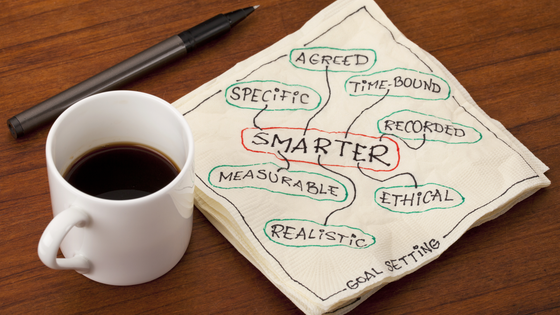Success Is on the Way: The SMART Goal-Setting Methodology
Have you ever had the feeling that despite all the hard work you have been doing, you still fail to achieve the desired result?

Perhaps, the reason is that you just choose the wrong means to achieve your goals or do not see them as clearly as you should. Indeed, a ship can't reach a harbor in a stormy night with no lighthouse to show the way. Our lighthouse must be knowing the correct goal, however, not all people know how to set goals properly. That is where SMART methodology comes in handy! It is indispensable both in work and in life. Let's figure out how, why, and where it can be used.
SMART is a goal-setting system

Unlike other goal-setting approaches, SMART allows you to clear up your ideas, concentrate your efforts, manage your time and resources productively, and increase your chances of getting what you want from life.
The SMART technique first appeared in time management back in the late 80s of the twentieth century. Created at the intersection of business and management, it became popular, although it happened a bit later. Its prehistory began in 1968, when Edwin Locke, an American psychologist, in his research concluded that any success is to a large extent predetermined by a properly set goal. A few years later, the concept of "management by objectives" directed by Peter Drucker, a management specialist, was born. In literature, such criteria of efficient goals as specificity, measurability, and deadlines began to surface. George Doran, a business-consultant, pulled all the ideas together: in 1981, Management Review published his article called "There's a S.M.A.R.T. way to write management's goals and objectives". That is how the official definition of this system was established, and the SMART method became ubiquitous.
But what does this abbreviation mean? Actually, these are the SMART goal criteria, namely:
S - Specific: well-defined, clear and unambiguous;
M - Measurable: having concrete indicators clearly illustrating your progress in achieving the goal;
A - Attainable: realistic, can undoubtedly be achieved;
R - Relevant: matching your life goal and the current situation;
T - Time-bound: tied to a particular period of time, i.e. there are precise dates of its beginning and finish.
So, with the SMART methodology, you can develop your ideas, link them to reality, find the optimal ways to implement them and motivate yourself. Why are the SMART goals more effective than usual ones? The point is that unrealistic or common goals predetermine our failure as the lack of a direction to follow makes us feel lost, place excessive demands on ourselves and waste our energy. SMART goals give us the opportunity to control our progress towards the result from start to finish.
They are also perfect for short-term planning, as well as for the situations depending solely on you rather than on external circumstances; it makes the outcome predictable. Consequently, the SMART goal technique cannot be applied under conditions of instability and uncertainty as well as for long-term planning. For example, there is no sense in setting a goal like "to become a boss in the next 3 years" - alas, the method will not work here.
Setting goals following the SMART methodology

Now, following the explained abbreviation, let's see how the SMART goal setting principle works in practice and illustrate this work with some examples.
- A goal must be specific
Specific goals have much more chances to be achieved. To specify a goal, you have to answer five questions:
- Who participates in achieving this goal along with me?
- What do I want to achieve?
- Under what conditions should this goal be achieved?
- When do I want to reach this goal?
- Why do I want to reach this goal?
For instance, a common goal may look like "I want to be in good form," while a specific goal, according to the SMART, must be formulated like "I want to buy a membership in the local gym and go there four days a week to improve my health and shape up."
- A goal must be measurable
According to this criterion, with no indicators to assess your progress towards the goal, you will not be able to realize whether you are moving in the right direction. To make the goal and meet the measurability criterion (and thus become reasonable), ask yourself:
- What do I want to get and how much?
- How will I know that I have already achieved my goal?
- What is the main indicator of my progress?
For example, to the specific goal above, you have to add the following: "Every week I will strive to lose one kilogram of my weight."
- A goal must be attainable
As mentioned above, the SMART goals setting methodology is a real-life oriented system. It means that, when setting goals, you should be realistic in assessing your skills, resources and exterior conditions. For example, one more reason why the goal "to become a boss in 3 years" is ineffective is that the promotion does not depend solely on you; the management of your company has too much impact, so you can't plan it. Exactly for this reason, i.e. to make the goal meet the criterion of attainability, ask yourself:
- Do I currently have the resources and possibilities to reach this goal?
- If not, what am I missing?
- Has anyone else been successful in this business before? If so, how?
Example: "I can pay for a year membership in a gym and know a fitness instructor who can help me. By the way, to lose one kg a week, other people simultaneously keep a diet - I think I should also try this."
- A goal must be relevant
Your goal must be in keeping with both your resources and motives. This means you must believe that achieving this goal is necessary. So, ask yourself:
- Do I really need to achieve this goal right now? Am I in too much of a hurry?
- Do I have enough time and resources to reach this goal?
- Doesn't it contradict my other goals and interests or those of others?
Example: "I have a tight working schedule and, besides, have to spend time with my family, so the only time when I can go to the gym is early morning or weekends. However, I also study English, so, I'd better take this time to finish the language course first and then will start doing sports."
- A goal must be time-bound
You have to be limited in time to get the sense of urgency which is a great motivating factor when it comes to achieving goals. To set a fixed and reasonable deadline, answer the following questions:
- Does my goal have a deadline?
- When do I want to reach my goal?
- Is it real to do everything within this time frame?
For example, based on the goal above: "On the 1st of August I am buying a membership in the gym and starting training. By the end of August, I consider my goal achieved if I lose four kilograms within the month."
Lectera’s Online Courses by topic
SMART as a sales technique

SMART goals setting can be used not only in daily life and for career building but also in sales. It is worth to note that in this area the SMART technique is in the highest demand. Many big and successful companies, including Apple, use it. It can be seen even from their press release: for example, in the sales goals list for the first quarter of 2018, Apple told about their plans to increase revenue up to $84-87 billion, while maintaining operating costs at $7.65-7.75 billion. This is a perfect example of how a company's marketing goal meets all the key criteria of the SMART methodology.
Let's study the examples of specific goals precisely in the field of sales. Let's look through the SMART goals criteria again and correspond them with the definition of the goals adapted to sales:
- S - Specific. The goal formulated like "We have to increase sales" is fundamentally wrong as it contains no detailed information. When speaking of profit, specify its size; when setting a goal for managers, specify the number of customers they are supposed to attract. Give your employees exact numbers to strive for. "Increase sales by 60%", for instance.
- M - Measurable. A goal put as "bring a product to market" may seem to fit the SMART goals setting system but in practice, you will not be able to measure the achievement of this goal. To meet this criterion, the goal should be put like "To sale 10,000 samples" or "To open 3 stores in this region."
- A - Attainability. Here, the key point is to reach balance - the bar should not be set too high or too low. You should mention all the tools that the company employees can use to reach the goals. At this stage, you have to build up a step-by-step plan for achieving the goal, a guide for managers and directors etc.
- R - Relevance. Remember that goal achievement should depend only on the managers. Say, a partner had delayed the delivery of equipment, which resulted in the failure of a deal with a customer, it is not the manager's fault. Nor is it those who are responsible for this "failed goal." The fact that the delay in delivery prevented the goal from being reached means that the goal was originally formulated incorrectly. In the SMART sales technique, the goals set for managers should not be beyond their competence.
- T- Timeliness. Deadlines should be discussed with managers and the whole team at staff meetings and briefings. The current skills of the employees and the tools they have at their disposal must be taken into account. To control the progress and meet the deadlines, you can use special software.
Here are some examples of the SMART goals in sales set under the SMART goal setting principle:
- Increase the number of closed deals from 30 to 45 a month per each salesman by sending the relevant staff to specialized courses to improve their sales techniques. The deadline is in three months. The progress will be tracked via the personal accounts of the staff members in the software.
Also, goals set under the SMART methodology can be formulated more briefly (still remaining specific):
- Increase the customer base by 20% in the second quarter by the means of email marketing.
- Open a company branch in the nearby town until January this year.
- Reduce delivery time within this autumn by 15 minutes by buying new scooters and bicycles for the couriers.
Now you know how to set goals following the SMART goal setting principles. Using this unique methodology, you can look at a problem from all angles and find the shortest and most efficient ways to solve it. It can be applied absolutely everywhere: at home, in your personal life, career, business management and even parenting. You have got the opportunity to make all your dreams come true! All you have to do is to set goals in accordance with the SMART goal setting technique and immediately begin their implementation.
Lectera’s Online Courses by topic
Share this with your friends via:
Latest News

A significant stage in the development of the alternative education system has begun in West Northamptonshire in the UK: the County Council is actively calling on parents, guardians, and trustees to participate in shaping the future of this key area.

Outwoods Primary School in Atherstone, Warwickshire, having experienced deep sadness after the loss of their famous cat, Silla, has found solace in a new pet – a Maine Coon named Aloysius O’Hara.

In modern universities, artificial intelligence, and in particular ChatGPT, is rapidly transforming from a controversial tool into a full-fledged student assistant.

An innovative educational project is gaining momentum in UK primary schools, aiming to change attitudes towards video games.

The Massachusetts Institute of Technology (MIT) presents MIT Learn – a revolutionary online platform that opens a “new front door” to access university knowledge and resources.












 How Not to Lose Focus When Learning Everything at Once: The Art of Selective Development
How Not to Lose Focus When Learning Everything at Once: The Art of Selective Development
 Test. What Winter Dessert Are You?
Test. What Winter Dessert Are You?
 What New Skills You Should Start Learning Today
What New Skills You Should Start Learning Today
 Test: What Kind of Ancient Goddess Are You?
Test: What Kind of Ancient Goddess Are You?
 Test: Which Great Woman Would Invite You for Tea?
Test: Which Great Woman Would Invite You for Tea?
 Test: How Well Do You Balance Work and Personal Life?
Test: How Well Do You Balance Work and Personal Life?
